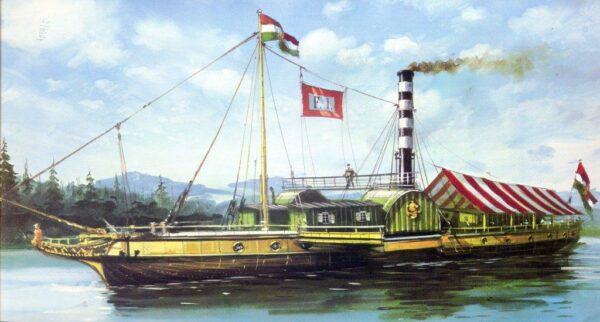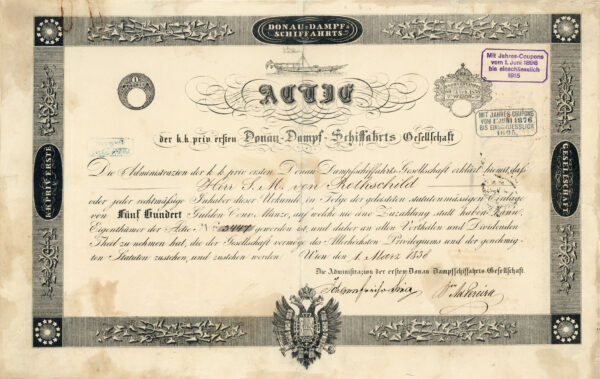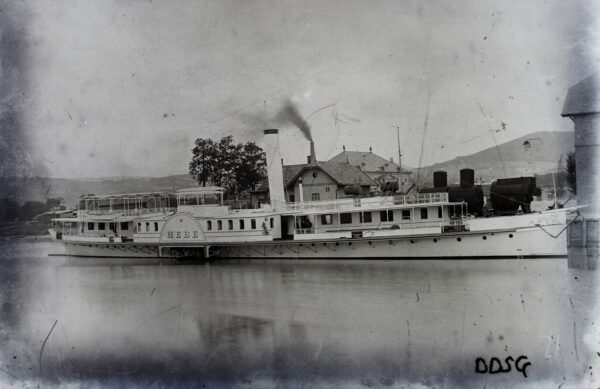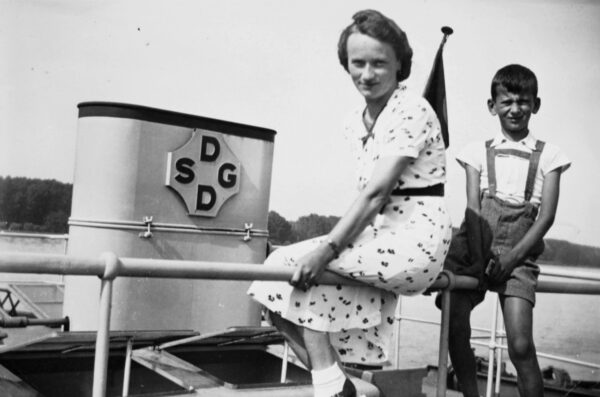First imp. and royal free Danube steamship Co.

The Danube flowed through a large part of the Habsburg Monarchy, but in a direction contrary to the commercial interests of the Empire (and within it, of Hungary). From the early 19th century, the Viennese court therefore supported all initiatives to promote upstream navigation on the river. However, the initial attempts, which were mostly capital-poor, were unsuccessful, and all those who attempted to use steam navigation failed. A major change came when two British entrepreneurs applied for patents. John Andrews and Joseph Pritchard were granted permission to steam on the Danube in 1828, and they brought English machinery to the vessels they built. They operated the ship they had built, the Franz I, but sold the ship itself to the new company, the Erste Kaiserliche und Königliche Privilegierte Donau-Dampfschiffahrts-Gesellschaft (First Imperial and Royal Privileged Danube Steamship Company, or DGT), and only leased it back. A significant part of the Austrian aristocracy and financiers had a stake in the foundation of the company.
Originally, István Széchenyi was invited to become a shareholder of the shipping company, but the Hungarian count was not interested in the enterprise at the time, and only later recognised its importance and became involved in the work of DGT. It was under Széchenyi's direction that the Iron Gate area was made accessible in the early 1830s, and it was at Széchenyi's suggestion that the company built a shipyard in Óbuda in 1835.
From 1845, the company also operated the crossing between Pest and Buda, displacing other entrepreneurs, but its main profile was the transport of goods and passengers on the Danube. The company built and operated a very large number of ships: in 1844 it had 6 sea and 21 river vessels, and by 1852 (despite losses during the War of Independence) it had 71 steamers and 233 barges. It bought coal mines to supply its ships, including the coal mines of Mecsek, but DGT also operated the Mohács-Pécs railway line.

The company's monopoly on the Danube was abolished by the Treaty of Paris of 1856, which ended the Crimean War and established free navigation on the Danube, and the "Danube Navigation Act", adopted there and enacted in 1858. From then on, the company had to face competition, first from the Austrian State Railway Company with its ships, and then from several smaller companies. In Budapest, the Budapest Screamer Crossing and Shipping Company, founded by István Türr, appeared in 1872.
One of its biggest competitors, the "United Hungarian Steamship Company" lasted until 1874, when it was merged into DGT, making it the largest river shipping company in the world at the time.
The smaller companies could not compete with DGT, and the company's own tariff policy did not serve Hungarian commercial interests, which is why the company was seriously challenged from the Hungarian side by the Hungarian River and Sea Shipping Company (MFTR), founded in 1895.
Hungary undertook the further regulation of the Iron Gate in order to develop Danube navigation, following the decision of the Berlin Congress of 1878, and this work was completed by 1896 with public investment.

The DGT's passenger branch carried the most passengers in 1883, after which the railways increasingly took passenger traffic away from river transport, but freight traffic increased until World War I.
The First World War and the subsequent border changes also brought changes in the company's life, as it had to give up part of its fleet in favour of the successor states. Between the two wars, the three largest shipping companies on the Danube, DGT, MFTR and Bajor Lloyd Shipping, therefore agreed to jointly transport goods and share resources, thus eliminating duplication and reducing operating costs.
The Second World War almost completely destroyed the company, and it was only slowly, after the signing of the Austrian State Treaty in 1955, that it was able to revive in Austria. The company was split into a passenger transport and a freight transport division in 1991 and privatised in 1993. Today there are two private companies under the DDSG name, DDSG-Blue Danube Schiffahrt GmbH, which operates the passenger vessels, and DDSG-Cargo GmbH, which operates the freight vessels.

Interesting facts:
At the inauguration of a DDSG ship, the "Széchenyi", launched in Óbuda in 1844, the anthem was sung for the first time in public.
The first Hungarian casualty of World War I was a Hungarian DGT ship captain, Károly Ebeling, who was captain of the steamer "Constitution" on the Al-Duna at the outbreak of the war when the Serbs fired shots at the civilian ship, and the captain was fatally hit.
The German name of DGT can be made into very long German words, one of the longest being Donaudampfschiffahrtselektrizitätenhauptbetriebswerkbauunterbeamtengesellschaft, which in Hungarian means "Association of the subordinate officials of the DGT maintenance building".
Sources
- Balázs Tinku:Patent Law and Early Danube Steamship (1810-1846)(in:Yearbook of the Hungarian Museum of Technology and Transport 2016)
- István Széchenyi: A few words about the' Danube navigation
- JÓZSEF BÍRÓ: 150 years of the Danube Steamship Company PUBLIC TRANSPORT JOURNAL XXIX, VOLUME 8, 1979
Founded on 13 March 1829.
Date of cessation: 1995
Founders: Archduke Ferdinand, Prince Joseph, Prince Metternich, S. M. von Rothschild
Securities issued:
| First imp. and royal free Danube steamship Co. |
Decisive leaders:
1830s, 1840s | Count István Széchenyi |
Main activity: shipping services
Author: by Domonkos Csaba
Founded on 13 March 1829.
Founders: Archduke Ferdinand, Prince Joseph, Prince Metternich, S. M. von Rothschild
Decisive leaders:
1830s, 1840s | Count István Széchenyi |
Main activity: shipping services
Main products are not set
Seats are not configured
Locations are not set
Main milestones are not set
Author: by Domonkos Csaba
First imp. and royal free Danube steamship Co.

The Danube flowed through a large part of the Habsburg Monarchy, but in a direction contrary to the commercial interests of the Empire (and within it, of Hungary). From the early 19th century, the Viennese court therefore supported all initiatives to promote upstream navigation on the river. However, the initial attempts, which were mostly capital-poor, were unsuccessful, and all those who attempted to use steam navigation failed. A major change came when two British entrepreneurs applied for patents. John Andrews and Joseph Pritchard were granted permission to steam on the Danube in 1828, and they brought English machinery to the vessels they built. They operated the ship they had built, the Franz I, but sold the ship itself to the new company, the Erste Kaiserliche und Königliche Privilegierte Donau-Dampfschiffahrts-Gesellschaft (First Imperial and Royal Privileged Danube Steamship Company, or DGT), and only leased it back. A significant part of the Austrian aristocracy and financiers had a stake in the foundation of the company.
Originally, István Széchenyi was invited to become a shareholder of the shipping company, but the Hungarian count was not interested in the enterprise at the time, and only later recognised its importance and became involved in the work of DGT. It was under Széchenyi's direction that the Iron Gate area was made accessible in the early 1830s, and it was at Széchenyi's suggestion that the company built a shipyard in Óbuda in 1835.
From 1845, the company also operated the crossing between Pest and Buda, displacing other entrepreneurs, but its main profile was the transport of goods and passengers on the Danube. The company built and operated a very large number of ships: in 1844 it had 6 sea and 21 river vessels, and by 1852 (despite losses during the War of Independence) it had 71 steamers and 233 barges. It bought coal mines to supply its ships, including the coal mines of Mecsek, but DGT also operated the Mohács-Pécs railway line.

The company's monopoly on the Danube was abolished by the Treaty of Paris of 1856, which ended the Crimean War and established free navigation on the Danube, and the "Danube Navigation Act", adopted there and enacted in 1858. From then on, the company had to face competition, first from the Austrian State Railway Company with its ships, and then from several smaller companies. In Budapest, the Budapest Screamer Crossing and Shipping Company, founded by István Türr, appeared in 1872.
One of its biggest competitors, the "United Hungarian Steamship Company" lasted until 1874, when it was merged into DGT, making it the largest river shipping company in the world at the time.
The smaller companies could not compete with DGT, and the company's own tariff policy did not serve Hungarian commercial interests, which is why the company was seriously challenged from the Hungarian side by the Hungarian River and Sea Shipping Company (MFTR), founded in 1895.
Hungary undertook the further regulation of the Iron Gate in order to develop Danube navigation, following the decision of the Berlin Congress of 1878, and this work was completed by 1896 with public investment.

The DGT's passenger branch carried the most passengers in 1883, after which the railways increasingly took passenger traffic away from river transport, but freight traffic increased until World War I.
The First World War and the subsequent border changes also brought changes in the company's life, as it had to give up part of its fleet in favour of the successor states. Between the two wars, the three largest shipping companies on the Danube, DGT, MFTR and Bajor Lloyd Shipping, therefore agreed to jointly transport goods and share resources, thus eliminating duplication and reducing operating costs.
The Second World War almost completely destroyed the company, and it was only slowly, after the signing of the Austrian State Treaty in 1955, that it was able to revive in Austria. The company was split into a passenger transport and a freight transport division in 1991 and privatised in 1993. Today there are two private companies under the DDSG name, DDSG-Blue Danube Schiffahrt GmbH, which operates the passenger vessels, and DDSG-Cargo GmbH, which operates the freight vessels.

Interesting facts:
At the inauguration of a DDSG ship, the "Széchenyi", launched in Óbuda in 1844, the anthem was sung for the first time in public.
The first Hungarian casualty of World War I was a Hungarian DGT ship captain, Károly Ebeling, who was captain of the steamer "Constitution" on the Al-Duna at the outbreak of the war when the Serbs fired shots at the civilian ship, and the captain was fatally hit.
The German name of DGT can be made into very long German words, one of the longest being Donaudampfschiffahrtselektrizitätenhauptbetriebswerkbauunterbeamtengesellschaft, which in Hungarian means "Association of the subordinate officials of the DGT maintenance building".
Sources
- Balázs Tinku:Patent Law and Early Danube Steamship (1810-1846)(in:Yearbook of the Hungarian Museum of Technology and Transport 2016)
- István Széchenyi: A few words about the' Danube navigation
- JÓZSEF BÍRÓ: 150 years of the Danube Steamship Company PUBLIC TRANSPORT JOURNAL XXIX, VOLUME 8, 1979